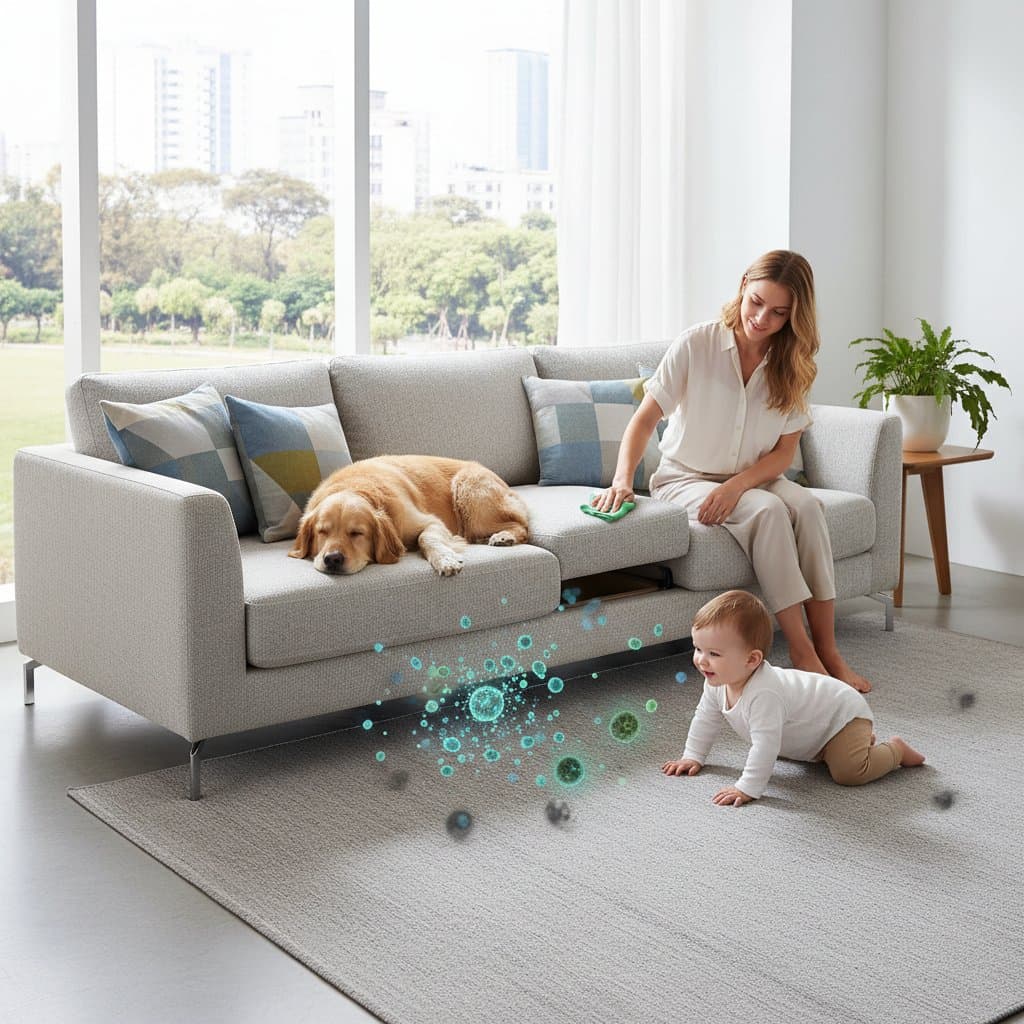Introduction to Antimicrobial Fabrics
Antimicrobial fabrics integrate protective treatments into textiles to inhibit the growth of bacteria, mold, and mildew. This technology enhances upholstery by reducing odor-causing microbes and simplifying maintenance. Homeowners benefit from longer-lasting furniture that maintains its appearance and hygiene without constant effort.
These materials suit various lifestyles, from busy families to those seeking eco-friendly options. By preventing microbial buildup, they contribute to improved indoor air quality and overall well-being. Selecting the right fabric involves understanding its properties and how they align with specific home needs.
Selecting the Right Fabric for Your Space
Choose antimicrobial fabrics based on your home environment to maximize performance. Consider factors such as traffic levels, climate, pets, and allergies when making selections.
- For high-traffic areas, select tightly woven fabrics like polyester or acrylic blends with integrated antimicrobial treatments. These options withstand spills, abrasions, and frequent use while preserving cleanliness.
- For humid climates, seek moisture-resistant weaves featuring mold-resistant properties. Such fabrics prevent musty odors and deterioration in damp conditions.
- For pet-friendly homes, choose stain-resistant microfiber or treated woven blends. These repel pet hair, dander, and odors, easing daily upkeep.
- For allergy-sensitive households, focus on fabrics certified for antimicrobial efficacy and low volatile organic compound emissions. Certifications ensure reduced allergens and safer indoor environments.
Request product data sheets from retailers to inform decisions. These sheets detail cleaning codes, fiber compositions, and treatment specifics. This knowledge enables accurate comparisons and selections tailored to your household dynamics.
Cleaning and Maintenance Simplified
Antimicrobial fabrics reduce the frequency and intensity of cleaning required for upholstery. While dust and dirt accumulate over time, these textiles allow stains to lift more readily and odors to dissipate quickly.
Vacuum upholstered surfaces weekly with a soft brush attachment to eliminate loose particles. Address spills promptly by blotting with a dry cloth to absorb liquids. Spot clean most treated fabrics using a solution of mild soap and water, steering clear of abrasive chemicals that might compromise the protective coating.
For removable covers, launder on a gentle cycle per manufacturer guidelines. Air dry to preserve the fabric's structure and treatment integrity. Regular maintenance paired with antimicrobial features significantly extends the upholstery's service life and visual appeal.
Sustainability and Long-Term Value
Antimicrobial fabrics support sustainable living by enduring daily demands and minimizing replacements. Their durability translates to less waste and lower resource consumption over time.
Many of these textiles incorporate recycled fibers and employ water-efficient production methods. This approach aligns with eco-conscious choices without sacrificing performance or aesthetics.
Designer Lena Wu notes, "Sustainability does not always mean raw linen or organic cotton. Sometimes it means choosing a performance fabric that keeps its beauty for a decade. That is its own kind of eco-conscious choice."
Renters can adopt these benefits through affordable additions like slipcovers or antimicrobial accent pillows. Such investments deliver hygiene and longevity without permanent alterations to living spaces.
Addressing Common Misconceptions
Misunderstandings about antimicrobial fabrics can deter potential users. Clarifying these points reveals their practical advantages for home settings.
One prevalent myth holds that these fabrics serve only institutional purposes, such as hospitals. In reality, the underlying technology enhances residential upholstery hygiene in everyday scenarios.
Another concern involves the durability of treatments, with fears they fade after washing. Premium fabrics secure antimicrobial agents at the molecular level, sustaining effectiveness through the material's typical lifespan.
Worries about chemical safety also arise. Established producers adhere to rigorous regulations, rendering cured treatments non-toxic and hypoallergenic. Check for certifications verifying compliance with indoor air quality protocols to confirm safety.
Integrating Antimicrobial Fabrics into Daily Life
Antimicrobial fabrics enhance home comfort by operating discreetly in the background. Their effects become evident through fresher scents, cleaner surfaces, and reduced upkeep demands.
This integration allows focus on enjoyment rather than chores. Living rooms invite relaxation, chairs retain their inviting feel, and spaces support gatherings without hygiene concerns.
Homeowners experience less stress in maintaining their environments. These fabrics enable personalization and use without compromise, elevating the role of furniture in daily routines.
Steps to Incorporate Antimicrobial Fabrics
Begin incorporation on a modest scale to assess suitability. Experiment with smaller items before larger commitments.
- Select antimicrobial throw pillows for sofas or beds. Observe their resistance to stains and odors during routine activities.
- Add a performance fabric ottoman to high-use areas. Track ease of cleaning and freshness over weeks.
- Evaluate results against expectations. If performance meets needs, proceed to reupholstering chairs or sectionals.
- Consult professionals for custom applications. Ensure selections match existing decor and functional requirements.
Gradual adoption builds confidence in these materials. They combine innovation with reliability, supporting enduring home improvements.
